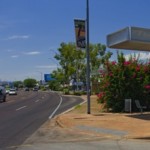(From the Wire is a new feature for DPJ. This section will include press releases received from reliable sources that help tell the story of the many happenings in Greater Downtown Phoenix. Yep, they are ripped from our inbox.)
The U.S. Environmental Protection Agency is calling upon local design firms to submit price quotes to give Phoenix’s Lower Grand Ave. a green makeover.
The firm selected will produce designs to improve the Lower Grand Avenue streetscape, making it more environmentally, pedestrian-, and bicycle-friendly, while maintaining the neighborhood’s artistic character. The design team will explore options that use green infrastructure techniques suitable for arid climates to capture and treat stormwater runoff. Options might also include improvements to pedestrian crossings, transit shelters, and bicycle paths.
Lower Grand Avenue is in Phoenix’s core and adjacent to downtown and the state capitol. Recent developments along Lower Grand Avenue reveal an emerging, grassroots effort to revitalize the area.
In 1998, a federally funded Weed and Seed project, which aimed to reduce violent crime by “weeding” out offenders and “seeding” community services, kick-started a partnership between city, federal, and state agencies, as well as the local faith community, residents, businesses, and nonprofits. This partnership has led to a 40 percent reduction in violent crime over the last 10 years.
Artists have colonized the street, taking advantage of inexpensive vacant and underused warehouse and shop spaces. The area is now a focus of an annual art festival and monthly First Fridays art events.
Phoenix and four other state capitals were selected from a total of 23 cities nationwide through the EPA’s Greening America’s Capitals program. The EPA is also funding private sector experts to provide sustainable design assistance to Montgomery, Ala.; Lincoln, Neb.; Washington, D.C.; and Jackson, Miss.
Greening America’s Capitals is a project of the Partnership for Sustainable Communities between EPA, the U.S. Department of Housing and Urban Development, and the U.S. Department of Transportation to help state capitals develop a vision of distinctive, environmentally friendly neighborhoods.
In addition to helping the selected state capitals build civic pride and a greener future, this assistance will help create models that many other cities can look to in creating their own sustainable designs.
For more information and to apply, please visit:
http://www.epa.gov/smartgrowth/greencapitals.htm
and
http://www.epa.gov/oamhpod1/pcsc/gac/phoenixrfq.pdf






